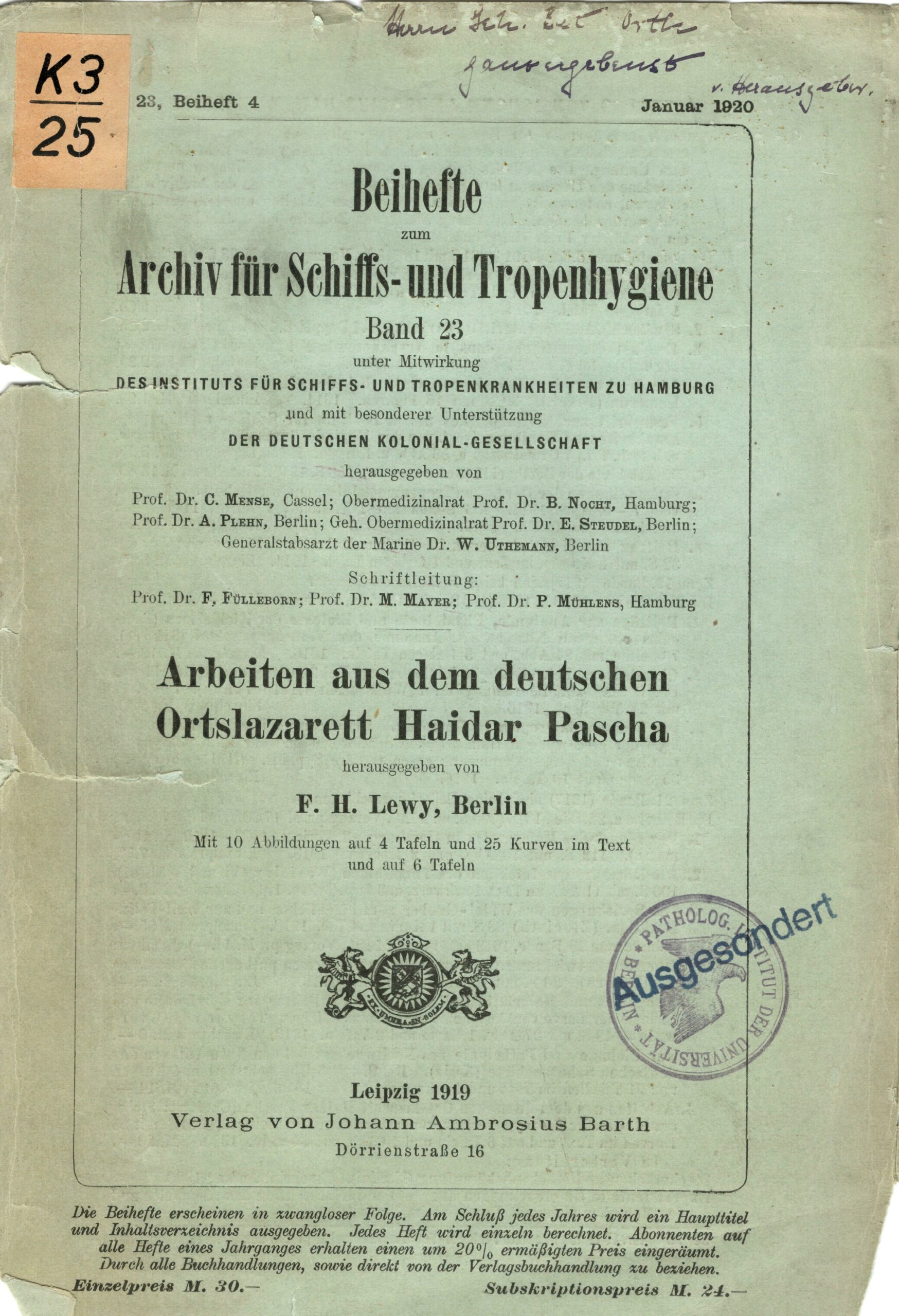Prof. Dr. med. Friedrich (Fritz) Heinrich Lewy
- Berlin, 28.01.1885
- Pennsburg, Pennsylvania, USA, 05.10.1950
- Member since 1926
- Escaped to the USA in 1934
- Berlin
- Neurologist/Neuropathologist
“I, Fritz Heinrich Lewy, a Jew, was born in Berlin on 28 January 1885 as the son of the “Geheimer Sanitätsrat” (privy medical councillor, honorary title awarded during the German imperial period) Dr. Heinrich Lewy. I attended the Friedrich-Werdersche Gymnasium here from 1894 to 1903 and graduated on Michaelmas 1903. I studied in Zurich and Berlin, where I passed the preliminary medical examination on Easter 1906 and the state medical examination at the end of 1908″, Fritz Lewy states in the curriculum vitae of his dissertation. His mother was Anna Babette Lewy, née Milchner. She would follow her son to the USA in 1936.
Education and Places of Work
Friedrich Lewy attended the Friedrichswerdersche Gymnasium in Berlin and studied medicine at the universities of Berlin and Zurich from 1903. He received his doctorate from the University of Berlin on 11 February 1910 with the thesis “Degenerationsversuche am akustischen System des Kaninchens und der Katze. Zugleich ein Beitrag zur Anwendung der Marchischen Methode”. Lewy was an assistant at the Institute of Physiology at the University of Breslau/Wrocław, Poland, from 1909 to 1910, and worked with Alois Alzheimer at the University Clinic for Psychiatry in Munich from 1910 to 1912. He moved to Breslau with Alzheimer in 1912. Lewy spent a short time with Ludwig Edinger at the Frankfurt Institute for Brain Research in 1914.
His research activities were interrupted by the First World War, in which he participated as a military doctor from 1914 to 1919. Lewy was deployed to France, Russia, and Turkey, especially to the Haidar Pasha local hospital in Constantinople. He published his own book on his experiences at this hospital in 1920, “Geschichte und Tätigkeit des Ortslazaretts Haidar Pascha”.
Lewy first discovered conspicuous intracellular protein aggregates (now known as α-synuclein) in degenerated neurons of the substantia nigra in patients with Parkinson’s disease in 1910 and published his findings in 1912. He reported on his findings during the 7th annual meeting of the Society of German Neurologists in 1913. The neuropathologist Konstantin Tretiakoff, who worked in Paris, named these protein deposits “Corps de Lewy” after their first describer in 1919. They were later also described in dementia of the Lewy body type.
Lewy worked as an assistant physician at the II Medical University Clinic of the Charité Berlin under Friedrich Kraus from March 1919 and under his successor Gustav von Bergmann from 1927. He habilitated in internal medicine and neurology in December 1921 with his contributions on the “Pathologie der Paralysis agitans”. He was appointed professor (extraordinarius) of physiology and pathology of the nervous system at the Friedrich-Wilhelms University in Berlin in 1923. Lewy acquired national and international recognition during the 13 years of his scientific work at the Berlin Charité.
Lewy started an independent neurological clinic (Hansaklinik) and a neurological research institute in Berlin, Lessingstrasse 46, on 1 July 1932. He was the medical director of the clinic and the institute.
Escape to England in 1933 and to the USA in 1934
Lewy was forced to give up his work at the Hansa Clinic in the summer of 1933. His authorisation to teach at the University of Berlin was revoked in February 1934 (§ 6 of the Law for the Restoration of the Civil Service of 7 April 1933, the paragraph referred to the “simplification of administration” when a position was abolished). Fritz Lewy fled to London with his wife at the end of the summer of 1933. He was, however, unable to find a satisfactory opportunity for further academic work there.
Therefore, Lewy and his wife left England for the USA from Plymouth aboard the French passenger ship Île de France on 24 June 1934. They reached New York on 3 July 1934. Lewy’s mother, Anna B. Lewy, who was born in 1864, fled from Germany to Brussels in 1934. She was able to leave Antwerp for the USA on 10 November 1936, where she joined her son.
In the USA, Lewy received support from the Rockefeller Foundation and from the Emergency Committee in Aid of Displaced Physicians, founded in 1933 and headed by George Baehr. The 49-year-old Lewy found a new job in Philadelphia as associate professor of neuropathology and research associate in audiology at the University of Pennsylvania School of Medicine. He also worked as professor of neuroanatomy at the Medico-Chirurgical College, School of Medicine in Philadelphia. Numerous publications in neurological journals in the USA bear witness to his activities. Lewy was a member of the American Neurological Association, the American Association of Neuropathology and the Association for Research in Nervous and Mental Disease.
Lewy received US citizenship in 1940. He referred to himself as Frederic Henry Lewey in the USA, and joined the Quaker religious community. He was deployed as a military doctor in the USA from March 1943 to the beginning of 1946.
Frederic Lewy died in Pennsburg, Montgomery County, Pennsylvania in 1950 at the age of 65. His gravesite is located at the Haverford New Meeting Cemetery, Haverford Township, Delaware County, Pennsylvania.
Acknowledgements
We are grateful to Wolters Kluwer Health for kindly allowing us to reprint the portrait of Lewey taken in 1949 [Brown JR The early years of the American Academy of Neurology 1947; 24: 1-9].
Sources and Further Reading
Sources




